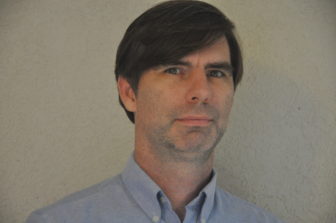Virgin Gorda is known for laidback luxury.
It is the second-most populated of the British Virgin Islands (BVI). It boasts swanky seaside villas, a five-star beach resort built by Laurance Rockefeller in the 1960’s, and the billionaires’ yachting playground of North Sound.
But in mid-August 2023,Virgin Gorda residents started complaining about the fetid odour of their tap water.
“When you take a shower, you come out smelling like sulphur dioxide — like bad eggs,” construction contractor Christina Yates said at the time.
The problem was widespread across The Valley, which is home to most of the island’s approximately 4,000 residents. Some said the water burned or gave them a rash when they showered. Others said it killed their house plants when they watered them. And soon, many residents had no tap water at all for hours or days at a time.
As the complaints grew louder, the government offered an explanation that many residents had suspected: Sargassum had entered the intake pipe at the desalination plant that produces most of the island’s public water. This problem had exacerbated longstanding issues with the water distribution system, leading to rationing that cut the supply nearly in half.
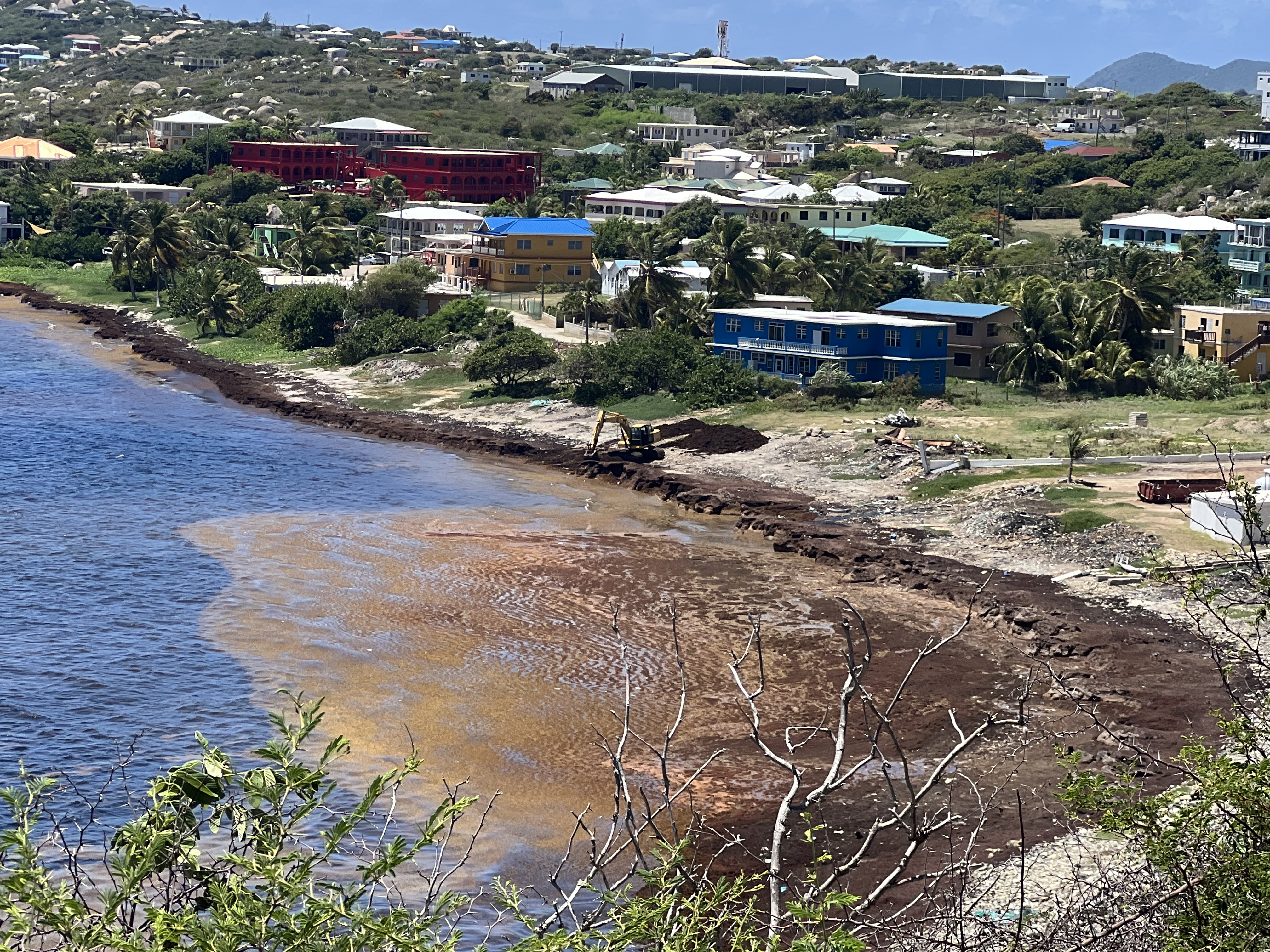
Sargassum lines the shore in Handsome Bay, Virgin Gorda, last September in the British Virgin Islands. The seaweed damaged the island’s main desalination plant, leading to water shortages and smelly tap water.
Photo by Anika Christopher | The BVI Beacon
The water crisis was not the first. In the BVI and other Caribbean islands in recent years, sargassum has periodically damaged water and electricity plants and left residents without basic services.
Last May in the Dominican Republic, for instance, sargassum knocked out a generation unit at the Punta Catalina Electric Generation Company, which produces about 30% of the country’s electricity, despite a $4 million investment in filters a year earlier.
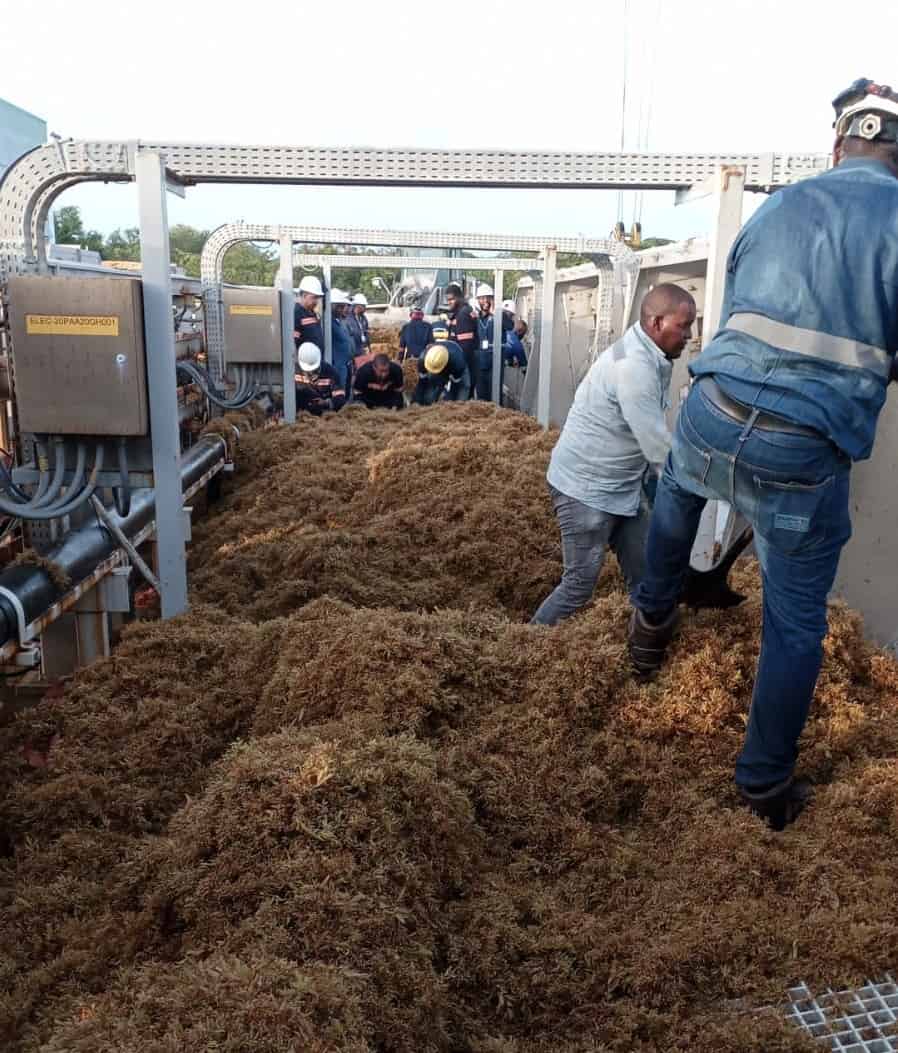
A team removes sargassum at the facilities of the Punta Catalina Thermoelectric Power Plant in the Dominican Republic in 2023.
Photo by courtesy Punta Catalina Thermoelectric Power Plant
In 2022, sargassum affected a desalination plant on St. Croix in the United States Virgin Islands so badly that the governor declared a state of emergency.
And in September 2021 in Puerto Rico, hundreds took to the streets to protest widespread, days-long power outages that the government blamed on the seaweed.
But despite this history, the BVI government had done little to prepare, even though its own draft sargassum management strategy warned since April 2023 of the risks at the Virgin Gorda plant and recommended measures that could have prevented the water crisis.
‘Emergency stages’
Following complaints in the summer, the government announced on Sept. 1 that it had “resolved” Virgin Gorda’s water issues by flushing water lines, conducting tests, and taking other steps. But residents said otherwise. On Sept. 20, they launched an online petition calling on government leaders to meet with them and explain the way forward.
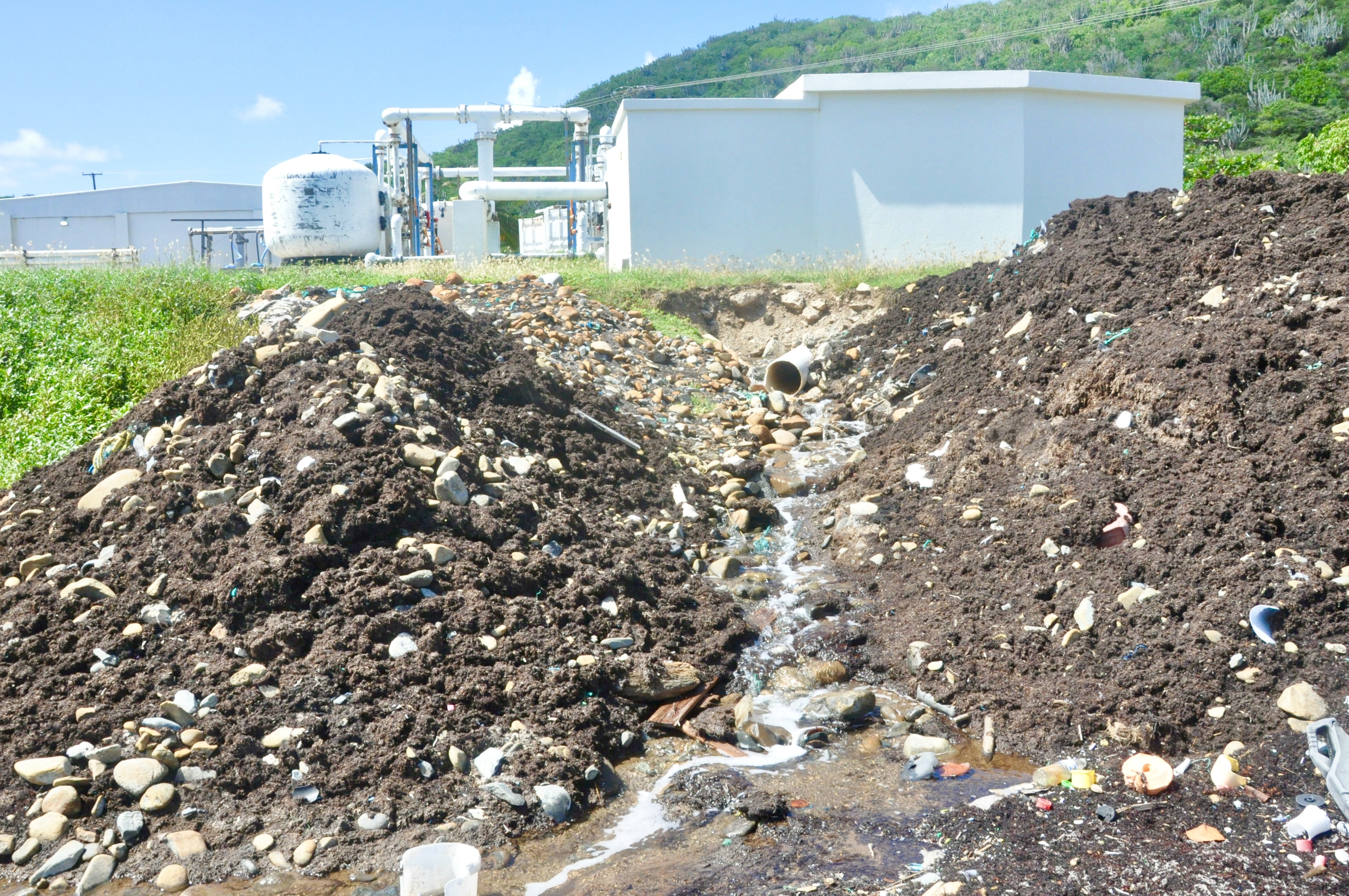
Sargassum, dirt and other debris were still piled on the shore in front of the desalination plant in Handsome Bay, Virgin Gorda, last November, more than two months after the seaweed damaged the facility.
Photo by Freeman Rogers | The BVI Beacon
“The situation has reached emergency stages in the last two weeks,” the petition stated, citing a 2010 United Nations resolution proclaiming “safe and clean drinking water and sanitation” as a basic human right. “We are very concerned that September is one of the periods of lowest water demand due to the off-peak tourism season and yet there appears to be low water levels. The lack of water creates unhygienic situations that concern our community especially now that schools are back in session.”
The petition received nearly 200 signatures, and the government responded by hosting a community meeting on Oct. 10.
Among the speakers was Michael Matthew, the general manager of the company Aqua Design BVI Limited, which operates the struggling desalination plant.
Since the previous winter, Matthew explained, sargassum had periodically washed ashore in mass quantities in Handsome Bay, the largely residential village where the water plant is located.
“Because it wasn’t removed, … after sitting on the shore for approximately eight months, it decomposed to the point where, after the seasonal tides changed with the rough weather, it actually brought some of the material all the way back out to our intake,” Matthew said as he showed photographs of shore-side sargassum mountains that reached several feet in height. “And what happened at that point in time, it started to overwhelm our structure. It’s not designed for sargassum.”
To protect the equipment, he explained, the plant cut production from around 360,000 gallons per day to as low as 230,000 gallons. He added that plans were in the works to replace membranes and install other new equipment with the hope of reaching a target of 430,000 gallons per day by the end of February 2024 — although attempts to confirm progress since then were unsuccessful.
Warning signs
Given the numerous warning signs, the water crisis shouldn’t have come as a surprise in the first place.
Since early spring, sargassum had regularly swamped shorelines across the territory.
On nearby Tortola in June 2023, it had entered an intake pipe at the main electricity plant, knocking out power for several hours for most of the island’s approximately 25,000 residents.
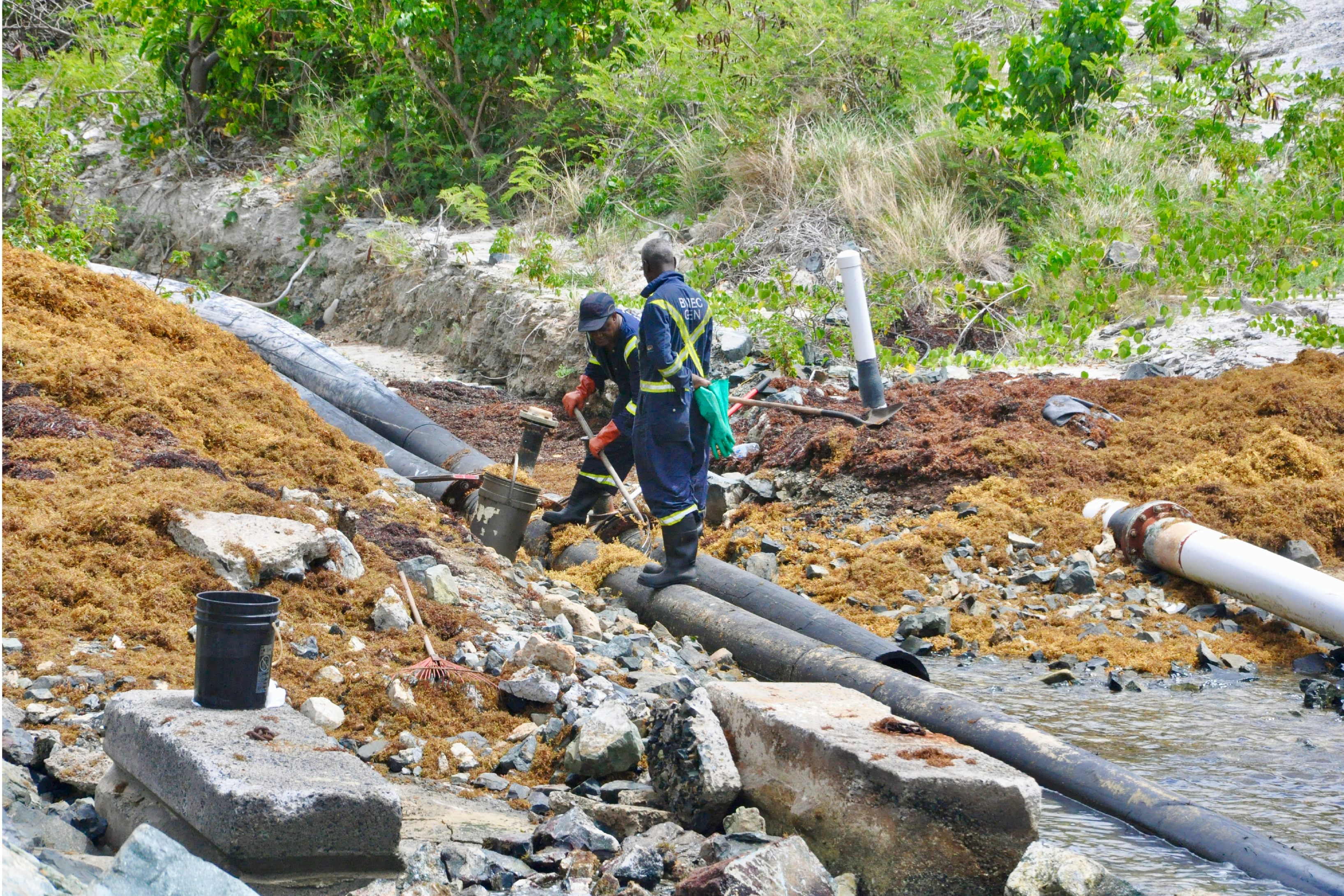
A worker cleans sargassum near the main electricity plant on Tortola in the British Virgin Islands on June 5, 2023. The day before, much of the island lost power for several hours after the seaweed was sucked into the intake pipe that provides cooling seawater to the plant.
Photo by Freeman Rogers | The BVI Beacon
But perhaps the most obvious red flag for Virgin Gorda was its own recent history.
In 2015, a sargassum influx knocked the Handsome Bay plant offline for nearly a year, forcing the government to install a temporary emergency facility. Officials have not disclosed the cost of the temporary facility or explained why a similar approach was not used last year.
But at the time, leaders took notice. In November 2015, the then-minister of Natural Resources promised a comprehensive sargassum policy and implementation strategy. The following March, British billionaire Richard Branson invited environment ministers and entrepreneurs from around the region to a sargassum symposium at his new resort on Mosquito Island in Virgin Gorda’s North Sound.
But despite this push, progress dragged, with delays exacerbated by major hurricanes in 2017 and then the Covid-19 pandemic.
A waste strategy drafted in 2019 included advice for handling the excess seaweed, but it wasn’t until April 2023 that the government created a draft sargassum management strategy as part of a project funded by about $290,000 from the United Kingdom government’s Darwin Plus program that also created strategies for the UK territories of Montserrat and Anguilla.
But a year later, the draft, which the BVI government provided on request, has not been officially adopted or even circulated in the public domain. And the Virgin Gorda water crisis suggests that the document has been largely ignored — just like the related recommendations in the 2019 waste strategy.
Vulnerable area
The 2023 draft strategy, in fact, identifies Handsome Bay as one of the three most sargassum-vulnerable areas in the BVI, and it explicitly warns of the risks associated with the desalination plant there.
Like the 2019 waste strategy, it also recommends several measures that could have helped prevent the water crisis: monitoring vulnerable areas with cameras; funding and creating an early-warning system; using booms and other equipment to collect sargassum before it reaches the shore; setting up systems for safely removing the seaweed from the shore in a timely manner; conducting hazard mapping at sensitive areas; and others.
But residents said such measures were not implemented in Handsome Bay to their knowledge. Loretta Demming, who runs a small shop and salon in the village, said diggers and trucks typically arrive to remove sargassum only when it reaches a crisis level.
“It has to be real, real bad,” she said.
Like other residents, Demming shared a litany of related complaints. The gas emitted by the sargassum turns jewelry and other metals black, she said, and she is no longer able to swim in the ocean near her home.
Ezekiel Bobb, a former hotel worker who has lived in Handsome Bay for about 30 years, said a more consistent and rigorous removal strategy is urgently needed.
“At least three times a week, you can have the JCB [digger] and a truck, and you just remove most of it,” he suggested, adding, “I think there should be more and more emphasis put into it, because it’s terrible.”
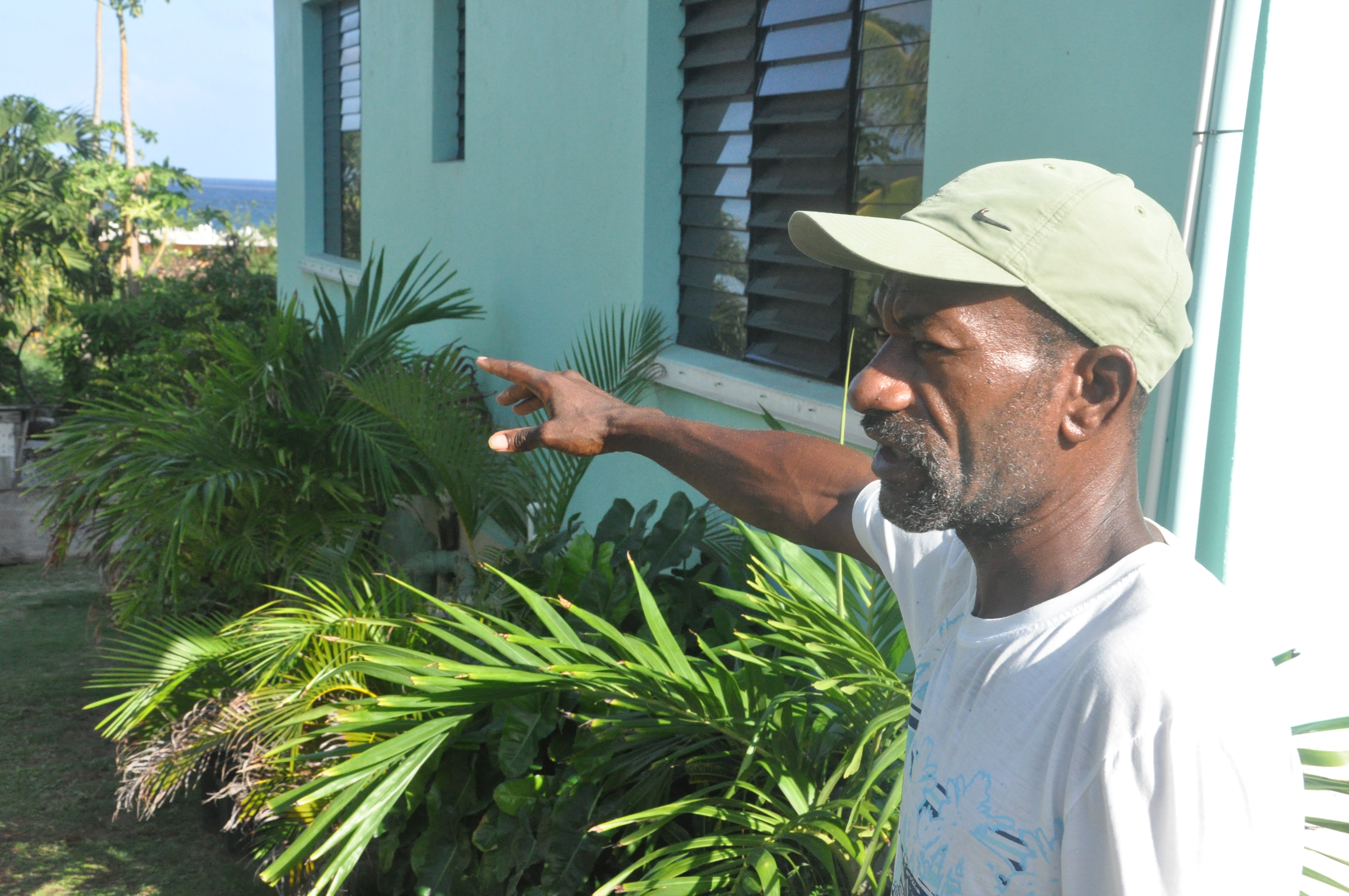
Ezekiel Bobb, a former hotel worker who lives in Handsome Bay, said a more consistent and rigorous sargassum removal strategy is urgently needed in the BVI.
Freeman Rogers | The BVI Beacon
He has tried to do his part by using sargassum for fertiliser in his garden, but he is unable to make much of a dent.
“Especially at night when you’re sleeping, it’s like somebody’s putting their finger in your nose when you’re trying to sleep to stifle you,” he said. “It’s like it’s blocking out your nostrils. Even if you close the windows tight.”
The ‘every-year surprise’
During the October meeting on Virgin Gorda, officials explained various plans for protecting the water plant in the future.
For instance, Matthew said, they had consulted with a dive company, which suggested reorienting the plant’s intake grill so the seaweed can’t fall directly into it.
“They also suggested extending [the 850-foot intake pipe] by 800 feet, which is very expensive,” he said. “That structure has been there for almost 30 years — 1994 we installed that. So adding 800 feet to it would put us outside of the normal zone that will be affected by the sargassum.”
That step, he said, would require funding from the government.
But it is unclear where the money would be sourced for such work. The BVI is an overseas territory of the United Kingdom — which makes it ineligible for most global climate financing — but it is financially independent and earns most of its government revenue from tourism and financial services.
The government’s 2024 budget, however, includes no specific line item for managing sargassum. And even the team that drafted the 2023 sargassum strategy noted that they were unable to obtain from the government the details of related allocations in the past.
BVI Health and Social Development Minister Vincent Wheatley, who represents Virgin Gorda in the territory’s legislature, lives in a house that overlooks Handsome Bay. In an interview for this investigation, he described longstanding struggles to find funding for a sargassum response in a territory that has been battered by other climate change impacts, including catastrophic damage from Hurricane Irma in 2017.
“I had put in $50,000 for the removal of the sargassum [in the budget in 2019], but it only lasted for like one year,” he said. “I don’t think the FS [Financial Secretary] or whoever saw it as something that needs to be in a budget all the time. That’s why I nicknamed sargassum the ‘every-year surprise.’ We never plan for it, as if it’s not going to come.”
And because of the territory’s status as an overseas territory, he said, accessing climate financing from abroad is usually not an option.
“We have no access to global funds: Resilience fund, the loss-and-damage fund,” he said. “What we are attempting to do is to find some avenue to get access to some funding.”
Long before the water plant was damaged last year, he added, he requested that the sargassum be removed early in the season. But the Ministry of Environment, Natural Resources and Climate Change — which he no longer oversees and which didn’t respond to requests for comment — didn’t react quickly enough, he said.
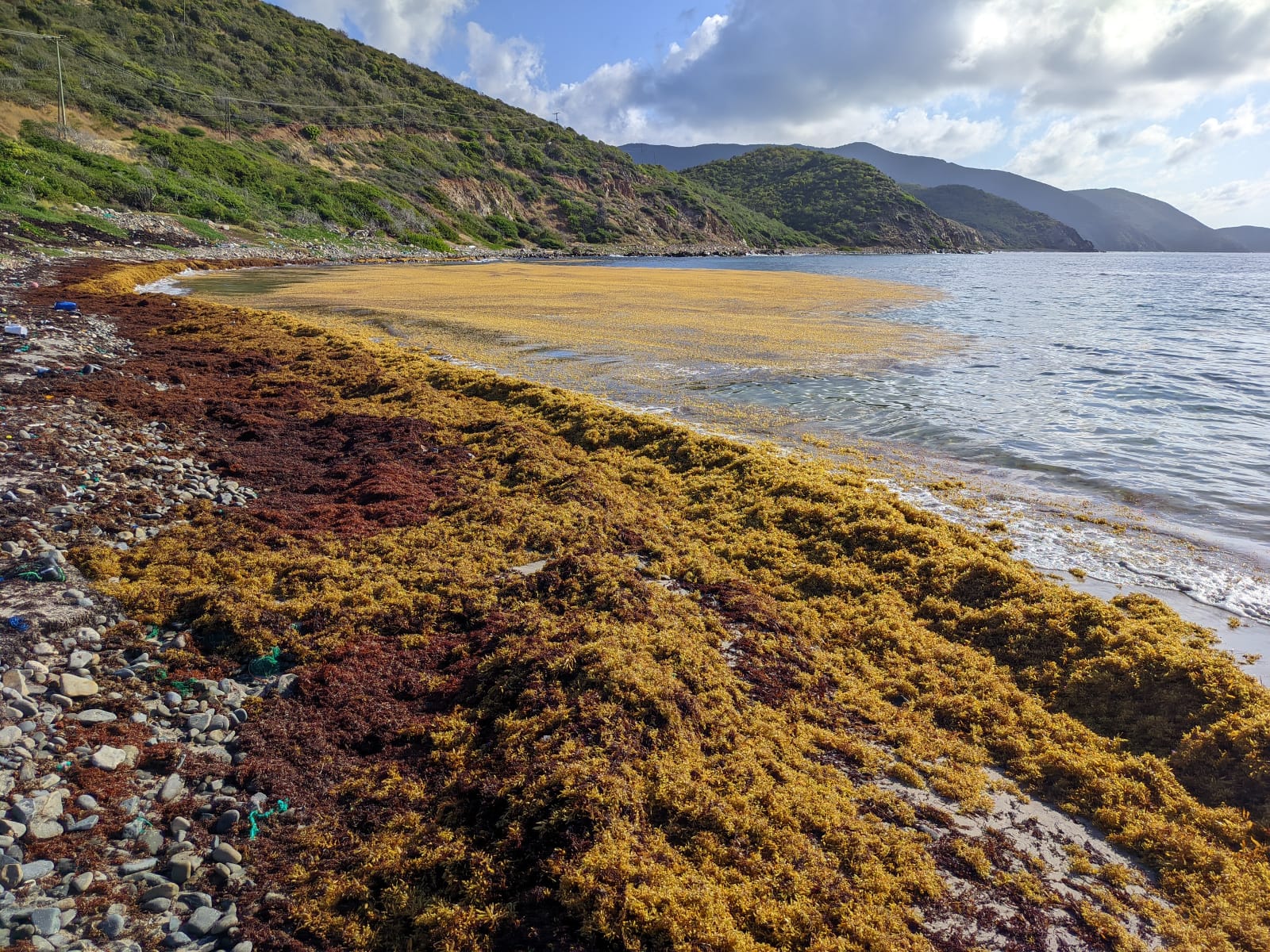
By April 8, 2024 (above), sargassum was once again washing ashore near the desalination plant at Handsome Bay, Virgin Gorda, but the promised protective boom had not been installed.
Photo provided
In January, however, BVI Premier Dr. Natalio “Sowande” Wheatley described sargassum management as one of his government’s priorities, and said that a boom would soon be installed in Handsome Bay to keep the seaweed away from the shoreline.
But by mid-March, residents had seen no sign of the boom, and attempts to obtain more information about that project and other planned measures in the area were not successful.
Meanwhile, sargassum has begun to wash ashore in Handsome Bay once again.
Reporters Rafael René Díaz Torres (Centro de Periodismo Investigativo), and Mariela Mejía (Diario Libre) contributed to this investigation.



